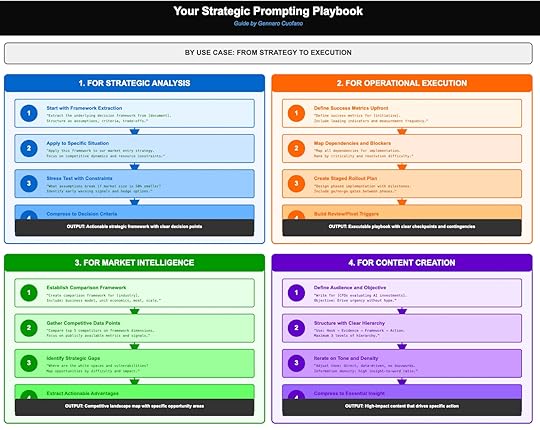Your Strategic Prompting Playbook

From Frameworks to Execution
AI isn’t just a tool for answering questions—it’s a system for structuring thought. But the value you extract depends entirely on the prompting strategy you deploy. Random questions yield random answers. Disciplined prompting yields actionable frameworks, decision clarity, and executable playbooks.
The Strategic Prompting Playbook lays out four core use cases: Strategic Analysis, Operational Execution, Market Intelligence, and Content Creation. Each follows a step-by-step prompting flow that transforms AI from a text generator into a structured thinking engine.
1. For Strategic AnalysisThe first use case is the backbone of executive decision-making: using AI to clarify frameworks, stress-test assumptions, and sharpen criteria for action.
Step 1: Framework Extraction
Instead of asking AI “What should we do?”, begin by extracting the decision structure from source materials—reports, case studies, or expert commentary. For example:
“Extract the underlying decision framework from this document. Structure as assumptions, criteria, and trade-offs.”
Step 2: Apply to Specific Situation
Next, force AI to adapt that framework to your context. If you’re exploring market entry:
“Apply this framework to our European expansion strategy. Focus on competitive dynamics and resource constraints.”
Step 3: Stress Test with Constraints
Frameworks look solid on paper until reality collides with assumptions. Stress test by shrinking market size, extending timelines, or tightening budgets. Ask:
“What assumptions break if market size is 50% smaller? Identify early warning signals and hedge options.”
Step 4: Compress to Decision Criteria
Finally, distill the analysis into clear, ranked decision points:
“Compress the framework into 3 prioritized decision criteria with trade-offs.”
Output: An actionable strategy framework, not generic advice—clear decision points, risk trade-offs, and contextualized application.
2. For Operational ExecutionAI excels at turning strategy into execution playbooks with checkpoints, contingencies, and monitoring systems. This prevents grand plans from stalling in implementation.
Step 1: Define Success Metrics Upfront
Force clarity by anchoring execution in measurable outcomes.
“Define success metrics for this initiative. Include leading indicators and measurement frequency.”
Step 2: Map Dependencies and Blockers
Ask AI to expose hidden friction points:
“Map all dependencies for implementation. Rank by criticality and resolution difficulty.”
Step 3: Create Staged Rollout Plan
Execution rarely works in a single leap. AI can design phased milestones with explicit go/no-go gates.
“Design a phased rollout plan with checkpoints. Include contingency triggers.”
Step 4: Build Review/Pivot Triggers
Plans without monitoring mechanisms collapse. AI can set thresholds for pivoting early.
“Define pivot triggers for budget overrun, adoption lag, or performance shortfall.”
Output: A clear operational playbook—timelines, triggers, dependencies—that reduces execution risk and builds accountability into rollout.
3. For Market IntelligenceInformation is abundant. What matters is comparative insight—understanding where you stand relative to competitors and where gaps can be exploited.
Step 1: Establish Comparison Framework
Start by defining the structure for analysis.
“Create comparison framework for SaaS players. Include business model, unit economics, moat, and scale.”
Step 2: Gather Competitive Data Points
Force AI to fill the framework with publicly available data.
“Compare top 5 competitors on the defined framework. Focus on metrics like pricing, retention, funding.”
Step 3: Identify Strategic Gaps
Ask AI to move beyond reporting and surface where competitors are vulnerable.
“Identify white spaces and vulnerabilities. Rank by difficulty to exploit and potential impact.”
Step 4: Extract Actionable Advantages
Finally, direct AI to synthesize recommendations:
“Extract 3 actionable opportunities for competitive advantage based on gaps identified.”
Output: A competitive landscape map with explicit opportunity areas—not just data, but direction.
4. For Content CreationContent is often where strategy meets the market. AI can help ensure messaging isn’t just polished, but strategically aligned and action-oriented.
Step 1: Define Audience and Objective
Generic content fails because it isn’t audience-specific. AI fixes this by framing purpose.
“Write for CFOs evaluating AI investments. Objective: drive urgency without hype.”
Step 2: Structure with Clear Hierarchy
Force messaging into evidence-backed structure.
“Use 3-level hierarchy: Hook → Evidence → Framework → Action.”
Step 3: Iterate on Tone and Density
AI can flex tone (direct, data-driven, narrative) and adjust information density.
“Reframe in a high signal-to-noise ratio. Cut buzzwords, maximize data-to-argument ratio.”
Step 4: Compress to Essential Insight
Finally, produce an executive-ready distillation.
“Compress to one paragraph with clear call-to-action.”
Output: High-impact content that drives decisions, not just noise.
Why This Playbook WorksEach module follows a repeatable flow of analysis → application → stress test → compression. This structure turns AI outputs from brainstorming into deliverables executives can act on.
The Playbook also resolves the three biggest failures in AI adoption:
Lack of Clarity: Prompts are too vague, producing shallow answers.Lack of Context: Users forget to tie outputs to objectives and constraints.Lack of Conversion: Insights remain abstract instead of being operationalized.By forcing frameworks, decision criteria, and staged execution, the Playbook ensures AI delivers leverage, not trivia.
The Strategic AdvantageTeams using this Playbook build faster cycles of learning and execution.
Strategy becomes structured and testable.Operations scale with built-in safeguards.Market intelligence turns into exploitable gaps.Content shifts from noise to precision influence.In short, AI stops being a novelty tool and becomes an operating system for decision-making.
ConclusionThe Strategic Prompting Playbook transforms AI from a passive assistant into an active driver of organizational momentum.
For Strategy: clear frameworks with decision points.For Execution: phased playbooks with contingencies.For Intelligence: competitive maps with actionable gaps.For Content: targeted messaging that drives outcomes.The shift is subtle but profound. You’re no longer “asking AI for help.” You’re running structured protocols that turn language into leverage.
The takeaway is simple: If you want AI to think with you, not for you, use a Playbook.

The post Your Strategic Prompting Playbook appeared first on FourWeekMBA.



